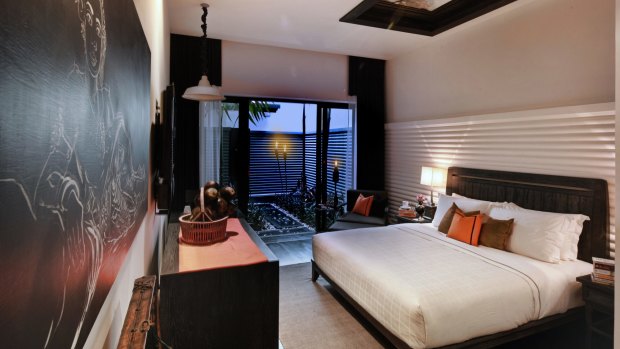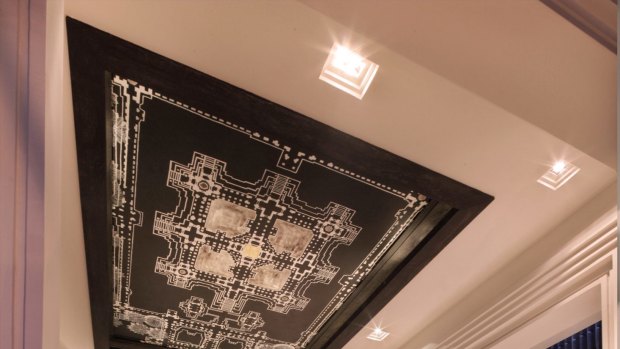This was published 9 years ago
Shinta Mani Hotel review, Cambodia: Changing rooms, changing lives
By Guy Wilkinson

Comfort: Superior garden room.
Siem Reap's boutique Shinta Mani Hotel is combining luxury with philanthropy.
In 2003 Cambodian entrepreneur Sokoun Chanpreda had a vision to turn a simple Post Office building into the most stylish boutique hotel in the country. There was just one problem. Who would run it? In a nation that has only opened its doors to tourism in the last 20 years, local people lacked the skills needed to operate at the level required.
He soon hit upon an idea. By establishing an on-the-job training program, he could not only foster staff of the highest calibre, but also provide young people with the skills needed to develop better employment prospects. Sokoun's innovative scheme soon developed a life of its own.

Grand entry: Shinta Mani reception area.
Nowadays, the Shinta Mani Hotel and Shinta Mani Foundation are inextricably linked, with a percentage of guests' nightly room rate helping to further the cause.
From humble beginnings, the modern-day hotel is something to behold. Having started life as an up-market 18-room boutique property, Sokoun teamed up two years ago with internationally acclaimed architect Bill Bensley. The two had previously collaborated on Hotel de la Paix to embark on a major refurbishment.
Since re-opening its doors in June 2012 the 39-room hotel is fast establishing a world-class reputation. Unsurprisingly, Bensley's designer stamp is all over it. Having "drawn inspiration from the bold, determined lines of Angkor Wat", the architect has created an understated, elegant feel throughout.
We look for the right personality, someone who really wants the opportunity.
Chitra Vincent
The colour scheme is predominantly monochromatic grey infused with eye-catching bursts of orange, an idea Bensley says stemmed from observing monks at Angkor temples, their vivid robes in stark contrast to the andesitic structures.
Along airy corridors, subtle water features lend a calming air, while Khmer-themed artwork adds a touch of panache to walls and alcoves. As the centrepiece, a long, rectangular infinity pool dominates a lush, open-air courtyard. It's a tranquil oasis, belying the fact the hotel is only a 15-minute tuk tuk ride from Angkor Wat or a short stroll to Pub Street and the city's hub of bars and restaurants.
But it's the staff that are the hotel's real trump card. Gracious smiles greet my every turn. Nothing seems too much trouble. In other places this could easily seem obsequious or annoying but here it feels genuine. It's no coincidence.
Each year, the executive director of the Shinta Mani Foundation, Chitra Vincent, receives up to 200 applications from local young people looking for a coveted place on the training scheme. The vetting process is extensive, with background checks and multiple interviews. There are only about 22 places are available.
"We look for a genuine sense of commitment," says Vincent. "Sometimes young people are so excited when they see an attractive new hotel they don't understand some of the pressures that come with the job. We look for the right personality, someone who really wants the opportunity."
Successful candidates will be trained in hospitality, reception or back office roles over a 10-month period. With dozens of new hotels springing up in Siem Reap every year, students who graduate from the program have no difficulty securing long-term employment elsewhere.
Almost all the recruits come from Siem Reap's neighbouring villages where the Shinta Mani Foundation is also playing a pivotal role in developing infrastructure in the form of education, healthcare and start-up businesses.
At nearby Wat Prey village, I see the results first-hand.
A short while ago, this village, along with dozens of others the foundation is assisting, was little more than a dirt patch, with entire families sleeping beneath ragged strips of tarpaulin. Now there is a school, fresh water, mobile dental and medical care and a degree of self-sufficiency.
Heading back to the luxurious confines of the hotel, I watch families plough rice paddies in the blistering midday heat. It's good to know the next generation can look forward to brighter prospects.
The writer was a guest of the Shinta Mani Hotel and Travel Indochina
TRIP NOTES
MORE INFORMATION
GETTING THERE
Vietnam Airlines offers fares year-round low season (January 16-November 29) return fares from Sydney and Melbourne to Ho Chi Minh City. Catch a connecting return flight from Ho Chi Minh City to Siam Reap with Vietnam Airlines. See vietnamairlines.com.
STAYING THERE
Shinta Mani Hotel, Junction of Oum Khun and 14th Street, Siem Reap. Rooms start at $US170 a night including breakfast for two adults. shintamani.com.
SEE + DO
Travel Indochina offers tailor-made holidays, small group journeys and Asia river cruises. There are many day trips and longer adventures available in and around Siem Reap, including the tremples of Angkor Wat. See travelindochina.com.au.
Sign up for the Traveller Deals newsletter
Get exclusive travel deals delivered straight to your inbox. Sign up now.